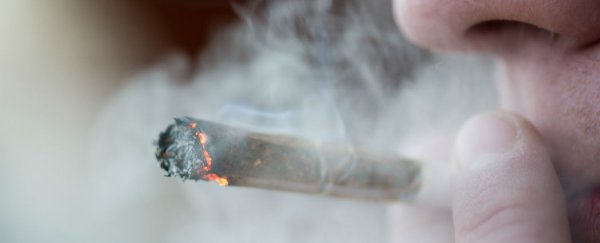Regular use of high-potency cannabis, nicknamed 'skunk', could lead to a higher risk of psychosis, a new study suggests.
Previous research has found that cannabis use increases a person's risk of experiencing schizophrenia-like psychosis, and a 2012 UK-based report called the Schizophrenia Commission rated cannabis use as the most preventable risk factor for psychosis. But what hasn't been clear is what makes one cannabis user more at risk than another. What factors increases a user's risk?
A team of researchers led by Marta Di Forti from the Institute of Psychiatry, Psychology and Neuroscience at King's College, London in the UK decided to focus on the potency of the cannabis being smoked, looking at the effects of hash versus the much more potent 'skunk-like' variety.
For the study, they looked at data from 780 people from South London between the ages of 18 and 65, over several years. Of these, 410 were patients with first-episode psychosis, and 370 were population controls. The participants were rated on various aspects of their cannabis use, including if they've ever used it, and if yes, how often they used it, what type they used, and how long for during each session. The researchers also looked at various other factors such as their backgrounds, genders, and use of other kinds of substances such as tobacco and alcohol.
The team found that those who used the more potent 'skunk' form of cannabis were significantly more at risk of having a psychotic episode than those who never used it, and those who used hash, the more common, and milder form of cannabis, showed no increased risk of psychosis. "Compared with those who had never tried cannabis, users of high potency skunk-like cannabis had a threefold increase in risk of psychosis," Di Forti told BBC News. "The results show that psychosis risk in cannabis users depends on both the frequency of use and cannabis potency."
Publishing in The Lancet, the researchers report that:
"The risk of individuals having a psychotic disorder showed a roughly three-times increase in users of skunk-like cannabis compared with those who never used cannabis. Use of skunk-like cannabis every day conferred the highest risk of psychotic disorders compared with no use of cannabis. The population attributable fraction* of first-episode psychosis for skunk use for our geographical area was 24 percent), possibly because of the high prevalence of use of high-potency cannabis in our study."
So why the difference between the two? Previous research has linked cannabis use to negative effects on a person's mental health and cognition based on the concentrations of a chemical called Tetrahydrocannabinol (THC). But, strangely enough, studies have also found that a different cannabis-based chemical, cannabidiol (CBD), could actually have a preventative effect on a user when it comes to psychosis. Skunk tends to have a lot more THC than hash - the proportion found in skunk is about 15 percent, whereas in hash, it's about 5 percent - and in hash, the proportion of THC and CBD is roughly the same.
New Scientist has a great rundown on why skunk has more THC, and the evidence for CBD's capacity to dampen psychosis.
Which begs the question, are the chemicals in hash evening out the risk of psychosis, while the unequal proportions in skunk are causing a higher level of risk? The researchers aren't ready to say for sure, just that there's an interesting correlation here that needs to be further investigated.
As Suzi Gage points out at The Guardian, studies like this are always difficult to glean something definitive from because there are so many factors at play:
"This study uses a case-control design. This type of study can lead to bias if the control population is not adequately selected. In this article, the controls were selected from people who lived in the same area of London.
However, the authors noted some difference between the cases and controls, in particular those with psychosis were more likely to be male, more likely to be white Caucasian, and more likely to be heavy smokers. Psychosis is more common in men, and more common in ethnic minorities (in particular those of migrant status). The authors accounted for these differences and adjusted for other potential confounders, but there could be others that weren't measured."
Despite the limitations of the study, it's a pretty important step towards quantifying the risks associated with using a strong or mild form of cannabis, so people can make better-informed choices about what they choose to consume. A psychotic episode can be devastating, as a cannabis user (it's not clear if that means hash or skunk) told BBC News, "It was utterly terrifying, and the worst night of my life. As someone affected by this issue, it is hard watching mainstream media, particularly comedy films, portraying cannabis as a harmless life-enhancing substance with limited ill-effects - it's simply not true."
Sources: The Guardian, BBC News, New Scientist
*Researchers commonly use a 'population attributable fraction' to measure the contribution of a specific risk factor to a disease or a death in a certain population. In this case, it's used to figure out the hypothetical reduction of psychosis in a population if exposure to skunk was reduced to zero.
